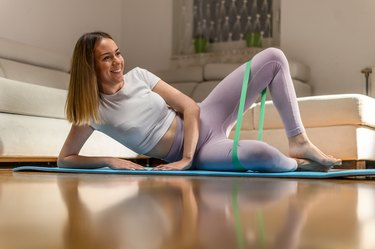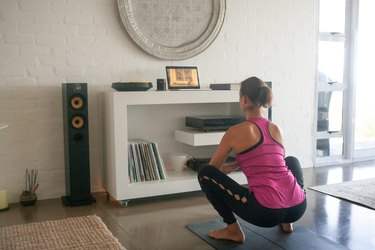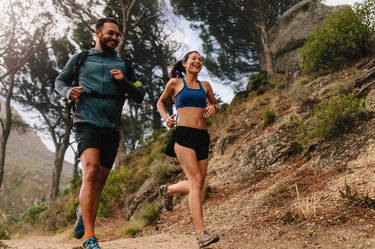
If you work out, it's likely you do a stretching or warmup routine before you start. But if you really want to keep good form and prevent an injury, physical therapists say you may want to add in a few pelvic stability exercises, too.
Your pelvis might not be the first thing you think about when you're about to go on a run, play a sport or lift weights, but no matter what type of movement you're doing, having a stable pelvis matters. It connects your lower and upper body, and it's home to many important muscles, ligaments and connective tissues that affect the way your whole body moves and functions.
Video of the Day
Read on to find out how stabilizing your pelvis can help you make the most of your workouts, and exactly how to do it.
Pelvic Stability and Exercise
"The pelvis is the center of the body and everything we do — every movement and every action — starts with force generated in the core and pelvis," says Lindsay Durand Massumi, PT, DPT, a doctor of physical therapy specializing in prenatal and pelvic health.
"The pelvis is also responsible for weight transfer activities like rolling, moving from sitting to standing and walking," Massumi says. "When we lack enough stability in the pelvis, or the muscles surrounding the pelvis don't fire appropriately, it can affect the way we move and exercise."
The muscles in and around our hips play a big role in how we move in each direction. Strengthening and mobilizing these muscle groups is important, especially if you exercise regularly.
"Over 30 muscles attach to the pelvis, including our pelvic floor muscles, our core, our hip rotators, abductors, adductors, extensors and hip flexors," explains Judith Meer, PT, DPT, a doctor of physical therapy specializing in pelvic health.
"And the hip controls our movement in three directional planes — the sagittal plane (forward and backward), the frontal plane (side-to-side), and the transverse plane (rotational movements)."
Performance and Injury Risk
Because our pelvis influences how we move in each direction, pelvic stability exercises can help us move more comfortably and efficiently no matter what type of workout we're doing. On the flip side, a lack of stability can really hurt us.
"When we don't stabilize the pelvis prior to exercise, we may not see the same improvements in strength, coordination or endurance," Massumi says. Over time, it may even lead to pain and injury.
"Imagine it like a tug of war from multiple directions: Weakness, tightness, overuse or injury in one area will affect how the others are able to function," Meer says. "The extra stress on those muscles, joints and ligaments makes them more prone to strain and irritation. Things like nagging knee or back pain, pelvic dysfunction or poor posture, for example, can all stem from issues around pelvic stability."
8 Exercises for Pelvic Stability
"Activating the muscles that support your pelvis, especially those that you will use for the exercise you're planning to do, is a great idea," Meer says.
"If you're playing basketball, with its frequent side/cutting movements, exercises that work on warming up and mobilizing the front plane will be beneficial. If you're going for a jog, exercises for the sagittal plane are helpful. If you're playing golf or tennis, working on the rotational aspects to target the transverse plane are useful."
Before your next workout, add a few of these PT recommended pelvic stability exercises to your routine. Pick at least three exercises and perform at least 3 sets of 10 to 15 reps (or, try them all!).
1. Lateral Lunge
"Lateral movements like the side lunge work your balance, stability and strength and can be made more challenging by holding weights or increasing your speed," Meer says.
- Stand with your feet at hip-width apart and your toes facing forward. Keep your hands on your waist.
- Shift your weight onto your left foot and step your right foot out toward the right. Keep your left leg straight.
- Keep your back flat as you bend your right knee and shift your hips back (almost as though you're squatting).
- Press into your right foot to return to your original stance.
- Do 10 to 15 reps, then switch to the other side.
2. Squats
"[Squats] are functional and can help with everyday activities like getting in and out of a chair or running after your kids," Meer says.
- Stand with your feet hip-width apart, pressing your feet firmly into the ground and engaging your core.
- Extend your arms out in front of you (clasp your hands if it helps with balance) and slowly bend your knees as you press your hips back. Keep your core engaged and your chest lifted.
- Lower your hips down as far as is comfortable, or until your thighs are parallel to the floor. Pause for a moment at the bottom.
- Press into your heels to stand back up into your standing position.
- Repeat for 10 to 15 reps.
If you don't like squats, Meer also recommends forward lunges for similar benefits.
3. Shin Box Get-Ups
Shin box get-ups work your hip flexors, tensor fasciae latae (thigh muscles involved in hip flexion, abduction and internal rotation), your glutes and adductors (inner thigh muscles).
- Sit up tall on a mat or the floor.
- Bring your right leg in front of you and bend your knee to a 90-degree angle, resting the outside of your thigh, shin, ankle and foot on the floor. Keep your toes pointing forward.
- Keeping your right leg in this position, sit up tall and bring your left knee to a 90-degree angle beside you. Your left inner thigh, shin and foot should be on the floor.
- Keep your back straight, your chest up and your hips facing forward as you engage your glutes and press your front knee into the ground, driving your hips up.
- Pause at the top and squeeze your glutes and quads, then sit back down.
- Do 10 to 15 reps, then switch to the other side.
4. Bridges and Pelvic Tilts
Pelvic tilts and glute bridges both help with glute engagement and pelvic alignment. "These exercises are a good place to start if standing exercises are causing discomfort," Meer says.
- Lie on your back with your arms resting by your sides, your knees bent and feet flat on the ground about hip-width distance apart. Your feet should be planted as close to your butt as possible.
- Keep your spine neutral throughout this exercise by pressing your shoulders down into the ground.
- Take an inhale, then on your exhale, press your heels into the ground as you drive your hips up toward the ceiling. Engage your core and glutes to lift you higher, and be careful not to arch your lower back.
- Hold this position at the top for a few seconds, then gently lower back down to your starting position.
- Do 10 to 15 reps.
5. Clamshells
Doing the clamshell exercise correctly works your glutes and helps improve your hip flexor strength and core stability.
- Lie on your side on a mat or on the ground with your legs stacked on top of one another. Bend your knees to a 90-degree angle.
- Press your heels and the insides of your feet together and squeeze your glutes to raise your top knee toward the ceiling.
- Keep your bottom leg grounded by pressing it into the floor, and don't let your pelvis fall forward or backward. (Your hips should remain stacked on top of one another.)
- Pause at the top, then slowly lower your knee back to the starting position.
- Do 10 to 15 reps, then switch to the other side.
6. Dead Bugs
Dead bugs make for a great core workout because not only do they engage the abdominal muscles, but they also recruit your pelvic floor and hip flexor muscles.
- Lie flat on your back with both arms reaching up toward the ceiling.
- Lift your feet off the ground and bend your knees to a 90-degree angle. Keep your lower back grounded on the floor.
- Slowly extend your right arm and left leg away from each other until they're both straight and hovering off the ground. Keep your abs engaged the entire time by drawing your lower belly up and in toward your spine.
- Pause for a moment, then slowly return your right arm and left leg to the starting position.
- Repeat the same motion with your left arm and right leg.
- Do 10 to 15 reps.
7. Bird Dogs
The bird dog exercise strengthens your obliques, glutes, hamstrings and back and stabilizes the pelvis.
- Start on your hands and knees in an all-fours position with your shoulders stacked over your wrists and your hips stacked over your knees.
- Look straight down to keep your neck long, engage your core to create a straight line from the crown of your head to your tailbone.
- Reach your left arm straight out in front of you until your bicep is in line with your ear. At the same time, reach your right leg straight out behind you.
- Pause here for a moment, then slowly return to your starting position.
- Switch sides, reaching your right arm forward and your left leg back.
- Do 10 to 15 reps.
8. Supine Marches
Supine marches work your core and pelvic floor and are an ideal prep for workouts that involve pelvic bracing.
- Lie on your back with your heels on the ground and your pelvis in a neutral position.
- Take a deep breath and on the exhale, do a gentle kegel and engage your core by drawing your lower belly up and in toward your spine.
- Then, lift your right leg up to a tabletop position, keeping your knee bent.
- Pause for a moment, then place your right foot down back to the starting position.
- Repeat the same motion with the left leg.
- Alternate legs for 10 to 15 reps.
Pelvic Stabilization Reminders
Keep in mind that pelvic stability is important, but you don't have to be completely "even" on both sides of your hips to move efficiently.
"Having a stable pelvis does not mean that we need to be perfectly level or evenly strong on both sides," Meer says. "We are all somewhat asymmetrical, whether that's in hip strength or limb length or foot size. As long as these differences are not causing pain or discomfort, there is no need to 'fix' them."
If you are experiencing discomfort or pain in your pelvis during your workouts or certain types of movement, it may be a good idea to see a physical therapist.
"A physical therapist can assess your hip stability, strength and alignment with a variety of tests to identify any issues, weaknesses or imbalances," Meer says. "They can help you develop an exercise plan that will shift you towards moving with confidence and ease again."


